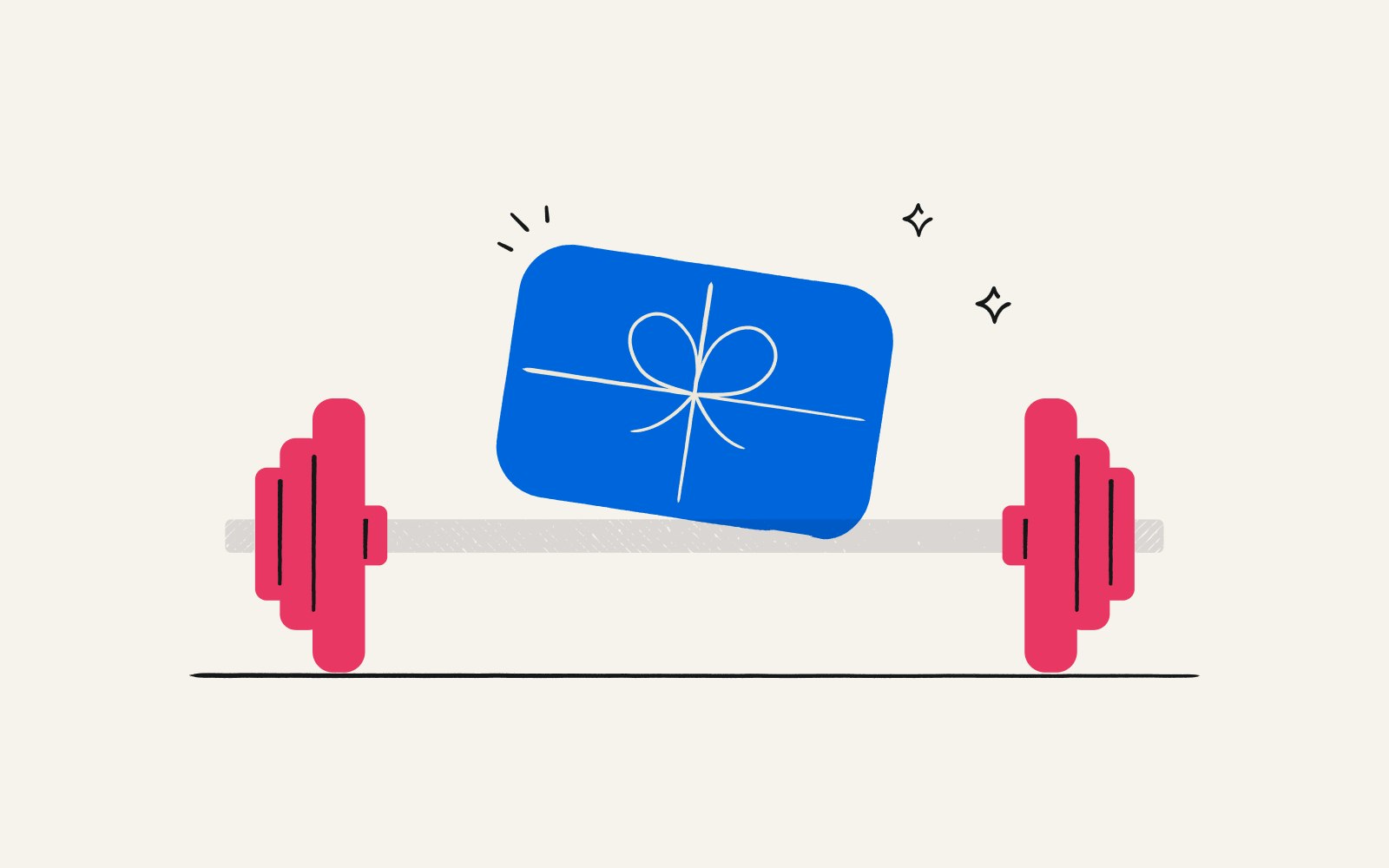Wellness incentives: Using fitness and health to reward employees
By Laura Ojeda Melchor●6 min. read●Jan 31, 2025

Wellness incentive programs can be tricky for HR teams to navigate. Despite mixed perceptions of these initiatives, they offer proven benefits like helping employees feel healthier and more productive at work and reducing costs for employers.
The key to creating a successful wellness program is designing one that resonates with your team. Let’s explore why health incentive programs are worth the effort and how to create one your employees will love.
What is a wellness incentive program?
A wellness incentive program is when an employer offers rewards or benefits to motivate employees to participate in health-related activities. It takes the concept of a wellness program and adds a layer of external motivation to drive employee participation.
In a 2013 study called Workplace Wellness Programs Study: Final Report, researchers Mattke et al. conducted a RAND Employer Survey to find out more about the effectiveness of corporate wellness programs. Their data found that “workplace wellness programs can help contain the current epidemic of lifestyle-related diseases, the main driver of premature morbidity and mortality as well as health care cost in the United States.”
In a nutshell, the results suggest that workplace wellness programs can positively impact employee health and drive medical costs down. This is a big deal. Medical costs affect employees, who pay insurance deductibles, and employers, who bear the burden of rising insurance premiums and lost productivity due to employee absences.
However, most employees aren’t willing to carve out time in their busy lives to participate in yet another work-related program — not without an incentive, that is.
Mattke et al. also found that employers who use incentives for screening activities report significantly higher participation rates than those who don’t: 63% versus 29% for [health risk assessment] completion, and 57% versus 38% for clinical screenings.
When employees feel overwhelmed or busy, incentives offer motivation to prioritize wellness. And when wellness is a priority, your employees can stay healthy and bring their best selves to work.
Types of employer-sponsored wellness incentives
Employer-sponsored wellness incentives come in all shapes and sizes, but they typically fall into two main categories: monetary and non-monetary.
Let’s break down each type and explore how they can drive engagement with your company’s wellness program.
Monetary wellness incentives
A monetary incentive is a tangible reward that motivates employees to participate in a wellness program. This type of incentive might include:
Cash rewards: Direct payments for completing health screenings or fitness challenges.
Gift cards and prepaid cards: Flexible options, often aligned with a fitness or wellness theme. Many employers let employees choose what type of reward they want with an employee rewards platform.
Health savings account (HSA) contributions: Monetary contributions to employee HSAs when they complete wellness milestones such as biometric screenings, annual wellness exams, or logging a certain number of gym visits.
Points systems: Employees earn points for activities like attending fitness classes, completing health assessments, or meeting step goals. These points can be redeemed for rewards like gift cards, cash, or wellness-related products.
Reimbursements: Payments that cover health and wellness expenses like gym memberships, fitness equipment, or wellness app subscriptions.
Monetary incentives are especially effective for employees because they deliver immediate value. There's nothing like logging a run or workout every weekday for a month and snagging a $50 Visa card in return.
Nonmonetary wellness incentives
Non-monetary incentives focus on creating experiences or providing access to resources that support employee wellbeing. These are often just as valuable as monetary rewards and can include:
Wellness days off: Extra paid time off for any well-being activity — physical, financial, mental, social, emotional, and spiritual.
Flexible work schedules and/or hybrid workspace: Flexible work hours or locations that fit employees' personal needs. These offerings can lower stress levels as employees navigate their own unique work-life balance.
On-site gyms or paid fitness programs: Workplace gyms, yoga classes, meditation sessions, fitness apps, or fully-funded gym memberships for employee use.
Built-in wellness time during the workday: Offering one or two paid wellness hours during the regular workweek for employees to use for everything from workouts to meditation.
Workplace perks: Access to ergonomic equipment, standing desks, or healthy snacks and meals in the office.
Non-monetary options may not give employees the same burst of dopamine that comes with a gift card or cash, but they can support a culture of wellness at your organization.
Implementing a wellness incentive program
Now that you know how to incentivize participation in wellness programs, it’s time to learn more about how to create a good one.
5-step starter guide
Understand employee needs: Survey your team to learn what wellness activities they value the most. Access to fitness classes or gym memberships? Mental health support? Flexible work options? A mix of all three?
Set clear, achievable goals: Figure out what success looks like. Is it increased participation in health screenings? Improved employee productivity and engagement? Reduced absenteeism? Pick one or two goals you can easily measure and set a participation target as well. You might start with a goal of enrolling 25% of your workforce during the first month, 35% the second month, and so on until most people are enrolled.
Choose the right incentives: Many organizations that offer incentives for wellness offer a blend of monetary and non-monetary rewards. Monetary rewards are great for motivating employees to participate in specific programs like exercise classes or health screenings. Non-monetary rewards can make your work environment more wellness-focused.
Spread the word: Launch your program with clear messaging that explains its purpose, benefits, and participation details. Use multiple channels to spread the word, including email, Slack, your intranet, and breakroom posters if you have physical workspaces.
Track and adapt: Monitor participation rates as your employee wellness incentive program takes flight. Regularly ask for feedback to help your team refine the program and keep it relevant.
Lessons from real-world wellness incentive programs
It’s critical to get employee buy-in before you start your program — and continue to incorporate their feedback throughout the life of your wellness incentive program.
Here are a few learnings from Reddit about the best and worst wellness programs.
From the best category:
“Subsidised gym membership and an optional flex day once a fortnight (time in lieu) are the best initiatives.”
“Being able to work flexibly.”
“Subsidised myki [Australian public transport card] and lunches up to $35 when you work in the office was nice.”
“We get a "well being" day one a quarter as well as a $200 gift card. The idea is we spend it on something special for ourselves on our well being day.”
From the worst category:
“A mental health day you needed to book out six weeks in advance. I better not have a spontaneous mental health breakdown!”
“Any initiative where not all employees can join in.”
“One of my first jobs, the company gave free dinners to whoever was working past 7pm at the office. This created a terrible culture where people would come in later in the morning or take longer breaks just so they could say they worked till late and expense a dinner!”
The key takeaway? Some seemingly good incentives can go sour if they’re implemented poorly. While there will always be a few bumps as you get your program started, if your HR team keeps listening to what your employees need and want, you’re much more likely to create a wellness program that everyone loves.
Examples of wellness incentives
Not sure where to start with wellness incentives? Here are a few examples from leading employers to kickstart your brainstorming process.
Online travel company Expedia Group offers a wellness and fitness reimbursement program. Employees can buy their choice of exercise equipment, fitness classes, fitness trackers, and other wellness items. Expedia Group then reimburses the cost up to a set yearly maximum. This could be part of why Expedia Group’s benefits program has an excellent 4.4 rating on Glassdoor.
Fintech giant Intuit gives employees a variety of wellness-focused perks, including an incentive program where employees can earn points for completing wellness activities. Once they rack up enough points, employees can trade them in for gift cards. Intuit also has an amazing 4.6 benefits rating on Glassdoor.
Companies like Microsoft, Salesforce, and Asana also offer employee health initiatives. They typically include a mix of incentive-based perks, like points programs and reimbursements, along with non-monetary benefits like wellness days, flexible work arrangements, mental health resources, support for parents, onsite gyms, and even paid naps.
No matter what size budget you have to work with, your HR team can create a compelling wellness incentive program that keeps employees motivated to stay healthy and active. By setting clear goals, listening to what employees want, communicating clearly and frequently about your program, and using a mix of monetary and non-monetary incentives to keep people motivated, your business can keep employees happy and reap the benefits of a healthier workforce.

